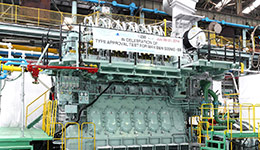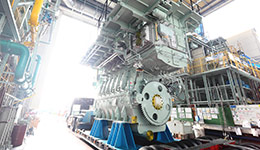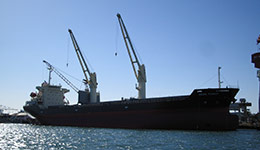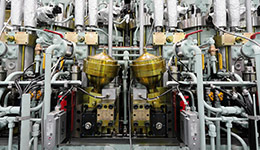Requiring the Best in Safety and Economic Efficiency
Ships are broadly classified as passenger vessels, cargo vessels, and fishing vessels. Of those, Makita Corporation engines are mainly used by cargo vessels. And for the engines of those cargo ships there are two important areas of performance that are required. The first thing all marine engines have in common is that their ships sail based on the assumption that the engines will perform reliably and safely, and second, superior economic performance is crucial to these cargo ships that play a leading role in global logistics.
Sailing Premised on Safety Performance
First and foremost a marine engine must be tough. An automotive engine is not expected to run continuously for 24 hours a day for days on end, but this is commonplace for a ship's engine. Once the ship leaves the harbor, its engine will not stop until it reaches its next port of call. If the ship's engine does stop, the ship is in immediate danger of stranding or drifting. In fact, in the market a desirable marine engine should be so tough that even if it is operating for 100,000 hours it will encounter no problems.
Also, in the unlikely event that an engine failure does occur while at sea, since the ship is out on the water, circumstances make it difficult for our company's engineers to be rushed out to make repairs. As a result, initially the ship's crew will need to respond to the problem. However, while there are some simple repairs that can be made by the crew, there is troubleshooting that can only be performed by an engineer working for the manufacturer. For these reasons, a marine engine with an easy to understand structure is required. Anything else will not do. This is a central reason that marine engines were for a long time not made electronic and instead a mechanical structure was favored.
The Best in Economic Performance
How efficiently can operations run at low cost? As a major player in global logistics, this can be said to be a central theme for us in the fierce competition surrounding the engines of cargo ships setting out to sea.
For most marine engines, diesel engines are used rather than gasoline engines, and this is because of diesel's impressive heat efficiency. Furthermore, due to these favorable combustion conditions any fuel can be used, and the fuel primarily used today is bunker C fuel oil, which is a very low quality, low price fuel. These marine engines work rigorously using this basically leftover oil (residual oil), which allows them to achieve the ultimate in energy-saving and low cost operations.
Automotive Engines & Marine Engines
Let’s talk about automotive engines and ship engines. With both engines fuel is combusted (ignited) in the engine's cylinders, and power comes from the firing of the pistons as a result of this combustion; the basic principles of operation are the same in both cases. In terms of just structure, the mainstream automotive engine is a four-stroke gasoline engine, and the most common marine engine is a two-stroke diesel engine. You may wonder what the origin of that difference is. Well, with the automotive engine it is considered general knowledge that two-stroke fuel economy is worse than four-stroke. But if that is a universal fact, why is the two-stroke adopted for the engine of a cargo ship where there is a greater demand for fuel efficiency?

These differences in the structure of automotive engines and marine engines are primarily the result of size and demand. First and foremost, being compact and lightweight are essential conditions for automobiles. Gasoline engines are more suited to those conditions (generally speaking, as more recently this cannot be said to be true in all cases). In terms of whether four-stroke or two-stroke is favorable, without going into too great of detail, in a gasoline engine the four-stroke represents greater reliability with regards to fuel economy and low to high-speed operability (this is also generally speaking).
However, the circumstances on a ship are different. First of all, ship engines are extraordinarily massive when compared with an automobile. The larger a diesel engine is the more its power and superior heat efficiency become apparent. Also fuel can be used in a more economically optimal way by purchasing inexpensive heavy oil. Furthermore, the large-scale diesel engines on marine vessels have an engine speed of 60-120rpms, and operate at ultra-low speeds, so per rotation each combustion, that is every two strokes drawing the maximum, can have heat efficiency as high as 50%. Because of these results, a large low-speed diesel engine can be said to be one of the best, most efficient engines.
When pursuing the best possible engine for a certain purpose, for an automotive a four-stroke gasoline engine is preferable, and on a ship a two-stroke diesel engine is best.














